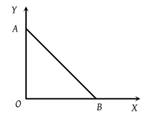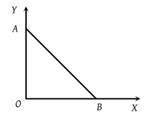A bullet of mass 2 gm is having a charge of 2 μC. Through what potential difference must it be accelerated, starting from rest, to acquire a speed of 10 m/s ?
| 1. | 5 kV | 2. | 50 kV |
| 3. | 5 V | 4. | 50 V |
2 gm द्रव्यमान की एक गोली 2 μC का आवेश वहन करती है। विरामावस्था से, 10 मीटर/सेकंड की चाल प्राप्त करने के लिए, किस विभवांतर के माध्यम से इसे त्वरित किया जाना चाहिए?
| 1. | 5 kV | 2. | 50 kV |
| 3. | 5 V |
4. | 50 V |
A square of side ‘a’ has charge Q at its centre and charge ‘q’ at one of the corners. The work required to be done in moving the charge ‘q’ from the corner to the diagonally opposite corner is -
1. Zero
2.
3.
4.
'a' भुजा के एक वर्ग के केंद्र पर Q आवेश स्थित है और वर्ग के एक शीर्ष पर 'q' आवेश स्थित है। आवेश ‘q’ को एक कोने से विकर्णत विपरीत कोने तक ले जाने में किए गए कार्य की गणना कीजिए -
1. शून्य
2.
3.
4.
As per this diagram a point charge +q is placed at the origin O. Work done in taking another point charge –Q from the point A [co-ordinates (0, a)] to another point B [co-ordinates (a, 0)] along the straight path AB is

1. Zero
2.
3.
4.
इस आरेख के अनुसार एक बिंदु आवेश +q मूल बिन्दु O पर स्थित है। सरल पथ AB के अनुदिश एक बिंदु आवेश -Q को बिंदु A [निर्देशांक (0, a)] से अन्य बिंदु B [निर्देशांक (a, 0)] तक ले जाने में किया गया कार्य ज्ञात कीजिए -

1. शून्य
2.
3.
4.
Four particles each having charge q are placed at the vertices of a square of side a. The value of the electric potential at the midpoint of one of the side will be
1. 0
2.
3.
4.
q आवेश युक्त चार कणों को भुजा a के वर्ग के शीर्षों पर रखा जाता है। किसी एक भुजा के मध्य बिंदु पर विद्युत विभव का मान क्या होगा?
1. 0
2.
3.
4.
A charge +q is fixed at each of the points ..... infinite, on the x-axis and a charge –q is fixed at each of the points ,..... infinite. Here x0 is a positive constant. Take the electric potential at a point due to a charge Q at a distance r from it to be . Then, the potential at the origin due to the above system of charges is
1. 0
2.
3. ∞
4.
x-अक्ष पर, ..... अनंत तक, प्रत्येक बिंदु पर समान आवेश +q स्थिर किया गया है और , ..... अनंत तक, प्रत्येक बिंदु पर समान आवेश –q स्थिर किया गया है। यहाँ, x0 एक धनात्मक नियतांक है। आवेश Q के कारण r दूरी पर किसी बिंदु पर विद्युत विभव लीजिए। तब, आवेशों के उपरोक्त निकाय के कारण मूल बिंदु पर विभव की गणना कीजिए।
1. 0
2.
3. ∞
4.
Point charge q1 = 2 μC and q2 = –1 μC are kept at points x = 0 and x = 6 respectively. Electrical potential will be zero at points
1. x = 2 and x = 9
2. x = 1 and x = 5
3. x = 4 and x = 12
4. x = –2 and x = 2
बिंदु आवेश q1 = 2 μC और q2 = –1 μC क्रमशः बिंदु x = 0 और x = 6 पर रखे गए हैं। विद्युत विभव किन बिंदुओं पर शून्य होगा?
1. x= 2 और x = 9
2. x= 1 और x = 5
3. x= 4 और x = 12
4. x = –2 और x = 2
If potential (in volts) in a region is expressed as V(x,y,z)=6xy-y+2yz, the electric field (in N/C) at point (1,1,0) is
1.-(3+5+3)
2.-(6+5+2)
3.-(2+3+)
4.-(6+9+)
यदि किसी क्षेत्र में विभव (वोल्ट में), V(x, y, z) = 6xy-y + 2yz के रूप में व्यक्त किया जाता है, तो बिंदु (1,1,0) पर विद्युत क्षेत्र (N/C में) ज्ञात कीजिए -
1.-(3+5+3)
2. -(6+5+2)
3. -(2+3+)
4. -(6+9+)
Electric potential at any point is , then the magnitude of the electric field is
1.
2.
3.
4. 7
किसी भी बिंदु पर विद्युत विभव है, तब विद्युत क्षेत्र का परिमाण है:
1.
2.
3.
4. 7
Ten electrons are equally spaced and fixed around a circle of radius R. Relative to V = 0 at infinity, the electrostatic potential V and the electric field E at the centre C are
1. and
2. and
3. V = 0 and
4. V = 0 and
दस इलेक्ट्रॉन R त्रिज्या के एक वृत्त पर समान दूरी पर आसपास स्थित किए गए हैं। अनंत पर, V = 0 के सापेक्ष, केंद्र C पर स्थिरवैद्युत विभव V और विद्युत क्षेत्र E हैं -
1. और
2. और
3. V = 0 और
4. V = 0 और
The electric potential V at any point O (x, y, z all in metres) in space is given by . The electric field at the point in volt/metre is -
| 1. | 8 along negative x-axis |
| 2. | 8 along positive x-axis |
| 3. | 16 along negative x-axis |
| 4. | 16 along positive z-axis |
आकाश में किसी भी बिंदु O (x, y, z, सभी मीटर में) पर विद्युत विभव V को द्वारा व्यक्त किया जाता है। बिंदु पर विद्युत क्षेत्र वोल्ट/मीटर में है-
| 1. | 8, ऋणात्मक x-अक्ष के अनुदिश |
| 2. | 8, धनात्मक x-अक्ष के अनुदिश |
| 3. | 16, ऋणात्मक x-अक्ष के अनुदिश |
| 4. | 16, धनात्मक z-अक्ष के अनुदिश |






